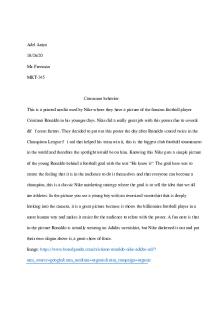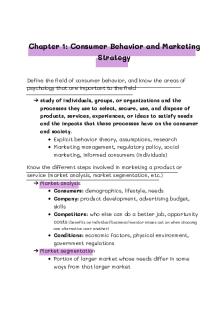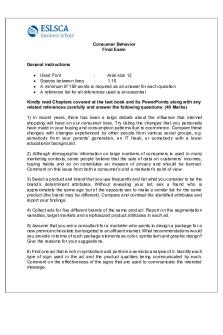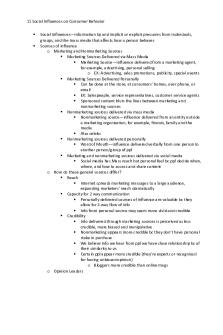Online Consumer Behavior: Confirming the AISAS Model on Twitter Users PDF

| Title | Online Consumer Behavior: Confirming the AISAS Model on Twitter Users |
|---|---|
| Pages | 17 |
| File Size | 1.3 MB |
| File Type | |
| Total Downloads | 238 |
| Total Views | 534 |
Summary
http://icsps2013.blogspot.com/2013_02_01_archive.html Online Consumer Behavior: Confirming the AISAS Model on Twitter Users* By Hendriyani, Jessica Jane, Lenny Ceng, Nabilah Utami, Reinata Priskila, Stefania Anggita Hendriyani ([email protected]) is a lecturer at the Communications Department ...
Description
Accelerat ing t he world's research.
Online Consumer Behavior: Confirming the AISAS Model on Twitter Users Reinata Priskilla, Lenny Ceng, Hendri Yani
Related papers
Download a PDF Pack of t he best relat ed papers
Jin, S.A. & Phua, J.J. (2014). Following Celebrit ies’ T weet s About Brands: T he Impact of T wit t … Joe Phua Jin, S.A. & Phua, J.J. (2014). Following Celebrit ies’ T weet s about Brands: T he Impact of T wit t er-Based… Joe Phua Effect of Social Media Market ing T hrough St arbucks Indonesia's Inst agram Account on Purchase Int … Widya A Rahmawat i
http://icsps2013.blogspot.com/2013_02_01_archive.html
Online Consumer Behavior: Confirming the AISAS Model on Twitter Users* By Hendriyani, Jessica Jane, Lenny Ceng, Nabilah Utami, Reinata Priskila, Stefania Anggita Hendriyani ([email protected]) is a lecturer at the Communications Department of University of Indonesia (Indonesia). Jessica Jane ([email protected]), Reinata Siahaan ([email protected]), Lenny Ceng ([email protected]), Nabila Utami ([email protected]), and Stefania Anggita ([email protected]) are students of Communications Regular Program of FISIP University of Indonesia. Abstract Today plenty of business entities use social media marketing strategy, especially Twitter, for their promotion media. The AISAS non-linear model, stands for Attention Interest Search Action Share, is developed by the Dentsu Way to explain online consumer behavior, replacing the conservative model of AIDMA (Attention Interest Desire Memory Action). This research aims to confirm the Model of Consumer Behavior in the case of product (BB) *
Presented in the International Conference on Social and Political Sciences (ICSPS) 2013, Karawaci, West Java, 25-26 February.
1
that uses only Twitter as its promotion medium. Using survey with purposive sampling method, we conduct pilot test on 70 Twitter followers of the product. Early findings indicate significant correlation between all variables –AISAS, except for correlation between Action and Share. AISAS model can be applied partially to explain the consumer behavior of Twitter users in this case. Further research with bigger sample and variety of products is needed to confirm the AISAS model in Indonesia context, where the social media marketing is still growing fast. Key words: social media marketing, AISAS model, Twitter, online consumer behavior.
Research Background Technology advances in a very fast speed now. Smartphone and other gadgets have become part of our life. Smartphone users can easily access social media, anytime anywhere; this feature contributes to the growth of Smartphone numbers in Indonesia (Antara, 2012). “Smartphone numbers in Indonesia will grow 6.5 times than 2011, and will continue until 2016. Data traffic using Smartphone will increase 238 times between 2011 and 2016” (Aco, 2012) One of social media which is booming in Indonesia now is Twitter. Twitter is micro blogging site that give its users opportunity to write something in 140 characters or less. In Indonesia, around 30 million people were Twitter users and about 2 millions were active tweeting every day (Ditya, 2012). These developments on technology and social media also influence marketing world. According to the America Marketing Association, marketing is defined as an activity or institution, and process of creating, communicating, delivering, and exchange value offering for customers, clients, partners and society (Lamb, Hair, & McDaniel, 2012, p.1). Based on this definition, marketing focuses on exchange. Exchange could be happened if there were two parties or more, interest and capabilities to give something to other parties, also if there was communication between parties. Advertising and promotion take role in that communication process. Companies seek for long term exchange relationship, not only one time relationship; therefore they try to build long term relationship with their consumers. In the past, advertising and promotions were done through mass media such as radio, television and printed media. But now, as the media develops, it is more difficult for marketers to engage with their consumers, especially because communication through mass media is less effective (Belch, & Belch, 2009). Today consumers are more listening to their friends‟ or relatives‟ advice about a brand than advertising. According to Nielsen Global Survey, word of mouth 2
communication is the new way of advertising because it is more credible (Kotler, Kartajaya, & Setiawan, 2010, p. 30). Consumers also actively seek for information about products, so that products or services could not give any false claim. Consumers also become powerful because of social media. Through social media, consumers could publish their own review about which product is good or bad; which could affect credibility of particular product or service (Meyerson, 2010). Realizing the social media power, marketers use it to approach their consumers now. Social media marketing is one of marketing tools that uses social media concept, promoting something (such as product, brand, or issue) and collaborating with society in social media campaign. “With social media tools, you can post a comment or video in seconds, directly from your laptop or most likely your mobile device” (Erik Qualman, 2009, p.39). Social media is supported by web format 2.0 that makes anyone possible to be producer or distributor; enabling “one to many” communication, or even “many to many” communication. Social media marketing makes word of mouth as a new promotion tool. By placing promotion information close to consumers, marketers could increase possibility those information would be communicated to other consumers. ( Peter & Olson, 2000, p.200). Many businesses already engage social media marketing strategy by using Twitter as their promotion tool. In Indonesia, Steak Hotel Holycow! and Hot Chips Maicih are examples of successful story of using Twitter as their online promotion tool (Bisnis UKM, 2012). In this research, we use BB social marketing strategy as our case. BB is the only business in Jakarta that specify its selling on Americas bread, bagel (Samira, 2011). The business was started on June 2011, but now it is already famous in Greater Jakarta. By using only Facebook and Twitter as its promotion tools, BB could attract many people (Pertiwi, 2011). Fathia Syarif, one of the owners said that Facebook and Twitter really help their promoting activities (Samira, 2011). For example, BB used Twitter to routinely deliver menu update, discounts and promos, as well as the location of Bagel booth car, Mobagel. BB also engaged Twitter to interact with its consumers by using mention system. Its account, @BB, already has 7000 followers by November 2012. BB gives 10 percent discount for its followers. Before transaction, the cashier will ask whether a customer is a Twitter follower or not.
3
We find it interesting to find out more about BB online consumer behavior, especially regarding Twitter. We seek answers for these research questions: 1. Does BB‟s social media marketing strategy influence its consumer behavior? 2. How is the online consumer behavior of BB‟s consumers? Theoretical Framework In 2004 Dentsu started to advocate a new consumer behavior model called AISAS (Attention, Interest, Search, Action, Share). AISAS is a non linear model, replacing the traditional model of AIDMA (Attention, Interest, Desire, Memory, Action). AISAS model has become a trademark in Japan since 2005. It is influenced by the emergence of new technology based social media. Internet technologies have evolved to the point where it is possible to instantly seek virtually any information, anytime, from anywhere, using a personal computer (PC) or mobile phone, or a similar device (Sugiyama & Andree, 2010). Consumers are less dependent on corporate Web sites they rather rely on the site „word of mouth‟ like blogs, Twitter, and Facebook (Kotler, 2010, p. 30). According Sugiyama & Andree, word of mouth communication is generated by two elements in the AISAS process: Search and Share, which will progress to action.
Figure 1. AISAS Model Attention
Interest
Search
Action
Share
(Source: Sugiyama & Andree, 2010)
The model suggests that a consumer, who notices a product, service, or advertisement (attention) and takes an interest in it, will gather information (search) about the item from internet –blogs, Twitter, Facebook, official website, etcetera- or by talking to family or friend who has used the product. The consumer then will evaluate the information. Positive evaluation will be followed by a firm decision to make a purchase (action). After the purchase, the consumer becomes a transmitter of Word-of-Mouth information, by talking to others or by posting comments and impressions on the Internet (share).
Figure 2. Changing from AIDMA to AISAS model 4
(Source: Sugiyama & Andree, 2010)
Because its flow is not linear, an element in the AISAS model can be skipped or repeated. For instance, a consumer might see a television commercial and immediately go to the store to buy it (Attention → Interest → Action), or he/she might be so interested to the product in the television commercial then he or she write about the commercial in his or her blog (Attention → Interest → Share). Figure 3. Nonlinear correlation between each element of AISAS Model
(Source: Sugiyama & Andree, 2010)
AISAS is a comprehensive model that anticipates the diverse behaviors of modern consumers. It suggests that a company should not only rely on advertising but also relationship between the company and its consumers. Marketers must strategically design a mechanism that will guide consumers to visit official website, then motivate them to search. It is important for marketers to provide brand experiences so that the consumer will empathize with the brand and want to make the purchase. Afterward, consumers will be gladly share their experiences on the blogs or social media, and increase the intensity of word-of-Mouth communications. 5
Research Hypotheses Based on above theoretical framework, we formulate the research hypotheses of this study that there are correlation relationship between Attention (V1), Interest(V2), Search(V3), Action (V4), and Share (V5). H1: Attention (V1) has significant positive correlation with Interest (V2) H2: Attention (V1) has significant positive correlation with Search (V3) H3: Attention (V1) has significant positive correlation with Action (V4) H4: Attention (V1) has significant positive correlation with Share (V5) H5: Interest (V2) has significant positive correlation with Search (V3) H6: Interest (V2) has significant positive correlation with Action (V4) H7: Interest (V2) has significant positive correlation with Share (V5) H8: Search (V3) has significant positive correlation with Action (V4) H9: Search (V3) has significant positive correlation with Share (V5) H10: Action has significant positive correlation with Share (V5)
Methodology Sampling method The population of this study is BB‟s consumers who make purchases at the location of Bagel booth car (Mobagel). We took 70 consumers who are also followers of BB Twitter. This sampling technique is categorized to non-probability sampling. 54 participants (77%) of 70 samples are women and 16 participants (23%) are men. There are 37% of them with age between 18 and 24 years old, 44% aged 25-30 years old, and 19% aged above 30 years old. There are 26 participants (23%) who identify themselves as college students, 61% are employees, 7% are entrepreneurs, and 6 participants (9%) have other occupation. Out of 70 samples who are also BB Twitter followers, 41% know BB from Twitter, another 41% know the product from friends and families, 17% know BB on the spot – because they found the outlet, and 1 person know BB from other sources. The samples have different frequencies of visit to BB store: 53% visit BB store once a month, 43% visit BB twice or thrice every month, 3% visit 4-5 times a month, and only one person visits BB store more than 5 times every month.
Measures 6
There are five variables in this study: Attention, Interest, Search, Action, and Share. Each variable is measured using 3 or 4 Likert scale type items. Each item ranges from 1 to 5, the higher score the more agreeable the sentence for the sample. Attention is defined as being aware and having the acknowledgement about BB from Twitter. The Cronbach’s Alpha for this variable is 0.806. Attention is measured by four indicators, among other: “I read the tweets from @BB on my timelines” and “I know BBs‟s foods and drinks menu from Twitter.” Interest is defined as being interested in any kind of product and promo that BB offers on Twitter. This variable is measured by four indicators, such as “I am interested in BB because of the photos of foods and drinks that @BB uploads on Twitter.” The Cronbach’s Alpha for this variable is 0.792. Searching refers to the effort to search any information about BB on Twitter. Searching is measured by four indicators, for example: “I look for any spesific information about BB from Twitter, such as breakfast menu, Mobagel‟s location, etc” or “I search any information about BB by mentioning @BB on Twitter.” The Cronbach’s Alpha for this variable is 0.731. Action is defined as making the purchase decision of any product because of the informations on Twitter. The Cronbach’s Alpha for this variable is 0.544. Action is measured by four indicators, including “I visit the location of Mobagel after reading the information about the location from @BB” and “I use the 10% discount promo that BB offers for the followers of @BB.” Sharing refers to the effort to share any information and also recommend BB on Twitter after purchasing any product of BB. The Cronbach’s Alpha for this variable is 0.802. Sharing is measured by three indicators, for example: “I update my tweets about the experience of purchasing any product of BB.”
Analysis Method Path analysis, first developed in the 1920s, is a method for examining casual patterns among a set of variables (Stage, Carter, & Nora, 2004, p.5). Path analysis is most used by researchers to analyze data relative to casual model, by conducting a series of regressions to analyze influences on dependent variables within the model (Stage, Carter, & Nora, 2004). In some models, there is one ultimate dependent variable that becomes researcher‟s focus attention. But this does not happen on every model. A regression is conducted for each dependent
7
variable and effects are calculated from all the regressions to find the cumulative effects (Stage, Carter, & Nora, 2004, p.5).
Findings There are five elements of the AISAS model that we use to analyze BB‟s online consumer behavior. First, we analyzed the variable and item separately. We found high score of Attention, Interest, Searching, Action, and Sharing. The detail of mean for each variables and items is showed on Table 1 below. Table 1. Mean for each item and variable Variable
Items
Mean per Item
Mean per Variable
Attention
Interest
Searching
Action
I read the tweets from BB on my timelines I know BB‟s foods and drinks menu from Twitter I‟m aware of Mobil BB (BB selling car) and its location on each day from Twitter Tweets from BB help me to remember all kind of information about BB; such as the menu, opening hours, latest promo, and Mobil BB location. I am interested in BB from the photos of foods and drinks that BB‟s Twitter account uploads on Twitter I am interested to find and know more about BB because I‟ve read the tweets from BB‟s Twitter account I am interested in any other kind of promo that BB‟s Twitter account informs on Twitter, such as free food for those who are having their birthdays and Happy Hour: 25% discount on Monday-Thursday, 06.00 p.m. – 08.00 p.m. I am interested in 10% discount promo that BB offers for the followers of BB‟s Twitter account I look for any information about BB by reading BB‟s Twitter account timeline on Twitter. I look for any spesific information about BB from Twitter, such as breakfast menu, Mobil BB‟s location, etc. I look for any information about BB by mentioning BB‟S Twitter account on Twitter I look for any information about BB by mentioning their friends on Twitter I purchased any food or drink at BB after read the informations from BB‟s Twitter account 8
4.1857 3.6429 4.0571
4
4.1143
4.0429
4.24285
3.9571 4.4857
4.4857 4.0857
3.55
3.9857
3.4143 2.7143 3.6857
4.01785
Sharing
I visit the location of Mobil BB after read the information about its location from BB‟s Twitter account I use the 10% discount promo that BB offers for the followers of BB‟s Twitter account I use any other kind of promo that BB‟s Twitter account informs on Twitter (free food for those who are having their birthdays or Happy Hour: 25% discount on Monday-Thursday, 06.00 p.m. – 08.00 p.m.) I update my tweets about the experience of purchasing any product of BB I update my tweets when I visit BB I recommend BB to my followers on Twitter
4.0143 4.3857 3.9857
3.7714
3.633
3.6857 3.4429
Because each item was measured using Likert type scale (range 1-5), the higher mean score of each item could be analyzed as the higher agreement of samples toward the item/statement. Table 1 shows that respondents tend to strongly agree with the all statements of Attention. The lowest mean score is 3.6429 for the statement, “I know BB‟s foods and drinks menu from Twitter.” The respondents also tend to strongly agree with all statements of Interest, except for “I am interested to find and know more about BB because I‟ve read the tweets from BB‟s Twitter account” which has 3.9571 mean score. Similar results can be found in all items of Action which has high mean score, the lowest one is 3.6857 for the statement, “I purchased any food or drink at BB after read the informations from BB‟s Twitter account” Somewhat lower scores are achieved by variable Searching (mean 3.55) and Sharing (mean 3.633). Compare to the other items, items of Searching have the lowest mean score, especially “I look for any information about BB by mentioning their friends on Twitter” with 2.7143 mean score that shows that participants are neutral with the statement, For element of Sharing, the mean score shows that participants tend to agree with the all statements.
The Analysis Model The analysis model that is constructed after the Path Analysis test shows that all research hypotheses are accepted, except for the last hypothesis. The details are as follow:
Figure 3. Analysis model based on Path Analysis
9
H1 is accepted; Attention (V1) has significant positive correlation with Interest (V2); with α = 0.000 and β = 0.637. H2 is accepted; Attention (V1) has significant positive correlation with Search (V3); with α = 0.000 and β = 0.408. H3 is accepted; Attention (V1) has significant positive correlation with Action (V4); with α = 0.002 and β = 0.305. H4 is accepted; Attention (V1) has significant positive correlation with Share (V5); with α = 0.009 and β = 0.312. H5 is accepted; Interest (V2) has significant positive correlation with Search (V3); with α = 0.000 and β = 0.509. H6 is accepted; Interest (V2) has significant positive correlation with Action (V4); with α = 0.000 and β = 0.483. H7 is accepted; Interest (V2) has significant positive correlation with Share (V5); with α = 0.003 and β = 0.353. H8 is accepted; Search (V3) has significant positive correlation with Action (V4); with α = 0.003 and β = 0.354. H9 is accepted; Search (V3) has significant positive correlation with Share (V5); with α = 0.006 and β = 0.3...
Similar Free PDFs

MRKT Consumer behavior model
- 7 Pages

Consumer behavior
- 5 Pages

Consumer Behavior
- 33 Pages

Lecture 6 Consumer Behavior
- 2 Pages

Consumer Behavior Final Exam
- 2 Pages

MCQs-Consumer-Behavior
- 24 Pages

Consumer Behavior quiz
- 1 Pages

Case Study Consumer Behavior
- 3 Pages

Jada May - consumer behavior
- 5 Pages

Consumer behavior séance 2
- 5 Pages

2 Symbolic Consumer Behavior
- 11 Pages
Popular Institutions
- Tinajero National High School - Annex
- Politeknik Caltex Riau
- Yokohama City University
- SGT University
- University of Al-Qadisiyah
- Divine Word College of Vigan
- Techniek College Rotterdam
- Universidade de Santiago
- Universiti Teknologi MARA Cawangan Johor Kampus Pasir Gudang
- Poltekkes Kemenkes Yogyakarta
- Baguio City National High School
- Colegio san marcos
- preparatoria uno
- Centro de Bachillerato Tecnológico Industrial y de Servicios No. 107
- Dalian Maritime University
- Quang Trung Secondary School
- Colegio Tecnológico en Informática
- Corporación Regional de Educación Superior
- Grupo CEDVA
- Dar Al Uloom University
- Centro de Estudios Preuniversitarios de la Universidad Nacional de Ingeniería
- 上智大学
- Aakash International School, Nuna Majara
- San Felipe Neri Catholic School
- Kang Chiao International School - New Taipei City
- Misamis Occidental National High School
- Institución Educativa Escuela Normal Juan Ladrilleros
- Kolehiyo ng Pantukan
- Batanes State College
- Instituto Continental
- Sekolah Menengah Kejuruan Kesehatan Kaltara (Tarakan)
- Colegio de La Inmaculada Concepcion - Cebu




